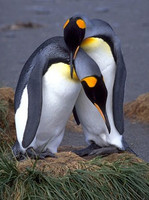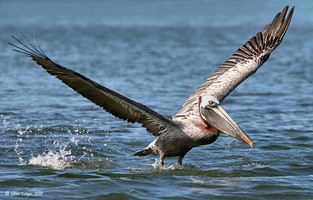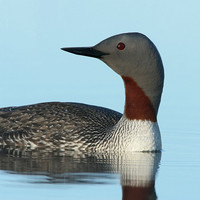'Water Birds'



This tree diagram shows the relationships between several groups of organisms.
The root of the current tree connects the organisms featured in this tree to their containing group and the rest of the Tree of Life. The basal branching point in the tree represents the ancestor of the other groups in the tree. This ancestor diversified over time into several descendent subgroups, which are represented as internal nodes and terminal taxa to the right.

You can click on the root to travel down the Tree of Life all the way to the root of all Life, and you can click on the names of descendent subgroups to travel up the Tree of Life all the way to individual species.
For more information on ToL tree formatting, please see Interpreting the Tree or Classification. To learn more about phylogenetic trees, please visit our Phylogenetic Biology pages.
close boxDiscussion of Phylogenetic Relationships
"Water Birds" is an informal name for a group including many though by no means all of the families that make their livings in the water.
Pelecaniformes and Ciconiiformes as defined here depart considerably from tradition. Pelecaniformes consists of all taxa that are closer to Pelecanus (pelicans) than to Ciconia (typical storks), while Ciconiiformes is all taxa closer to Ciconia than Pelecanus. In practice, this results in Pelecaniformes swallowing up all the traditional ciconiiform families except Ciconiidae, which remains the sole ciconiiform family.
References
Hackett, S. J., Kimball, R. T., Reddy, S., Bowie, R. C. K., Braun, E. L., Braun, M. J., Chojnowski, J. L., Cox, W. A., Han, K.-L., Harshman, J., Huddleston, C. J., Marks, B. D., Miglia, K. J., Moore, W. A., Sheldon, F. H., Steadman, D. W., Witt, C. C., and Yuri, T. 2008. A phylogenomic study of birds reveals their evolutionary history. Science 320(5884):1763-1768.
Title Illustrations

| Location | Gold Harbor (South Georgia Island (South Georgia and South Sandwich Islands)) |
|---|---|
| Comments | king penguin |
| Creator | Gerald and Buff Corsi |
| Specimen Condition | Live Specimen |
| Source | Aptenodytes patagonicus; King Penguin |
| Source Collection | CalPhotos |
| Copyright |
© 2001 California Academy of Sciences

|
| Scientific Name | Gavia stellata |
|---|---|
| Location | Nome, Alaska, USA |
| Specimen Condition | Live Specimen |
| Source | Red-throated Loon |
| Source Collection | Flickr |
| Image Use |
 This media file is licensed under the Creative Commons Attribution-NonCommercial-ShareAlike License - Version 2.0. This media file is licensed under the Creative Commons Attribution-NonCommercial-ShareAlike License - Version 2.0.
|
| Copyright | © 2007 Ashok Khosla |
About This Page
Page copyright © 2008
 Page: Tree of Life
'Water Birds'.
The TEXT of this page is licensed under the
Creative Commons Attribution-NonCommercial License - Version 3.0. Note that images and other media
featured on this page are each governed by their own license, and they may or may not be available
for reuse. Click on an image or a media link to access the media data window, which provides the
relevant licensing information. For the general terms and conditions of ToL material reuse and
redistribution, please see the Tree of Life Copyright
Policies.
Page: Tree of Life
'Water Birds'.
The TEXT of this page is licensed under the
Creative Commons Attribution-NonCommercial License - Version 3.0. Note that images and other media
featured on this page are each governed by their own license, and they may or may not be available
for reuse. Click on an image or a media link to access the media data window, which provides the
relevant licensing information. For the general terms and conditions of ToL material reuse and
redistribution, please see the Tree of Life Copyright
Policies.
- First online 27 June 2008
- Content changed 27 June 2008
Citing this page:
Tree of Life Web Project. 2008. 'Water Birds'. Version 27 June 2008 (under construction). http://tolweb.org/%27Water_Birds%27/123207/2008.06.27 in The Tree of Life Web Project, http://tolweb.org/












 Go to quick links
Go to quick search
Go to navigation for this section of the ToL site
Go to detailed links for the ToL site
Go to quick links
Go to quick search
Go to navigation for this section of the ToL site
Go to detailed links for the ToL site